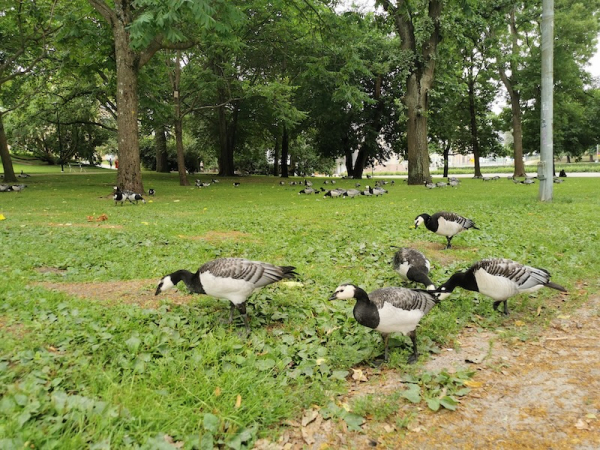Barnacle goose chick numbers rise sharply in capital region

Barnacle geese in Kaisaniemi Park, Helsinki. Photo: Aleksi Mikola, Finnish Environment Institute
- Next Article Finnish economy shrinks as consumption weakens in second quarter
The number of barnacle goose chicks in Finland’s capital region increased significantly during summer 2025, despite the total adult population remaining stable. The figures come from a joint monitoring programme led by the Finnish Environment Institute (SYKE) and BirdLife Finland.
The survey, conducted at the end of July, counted 5,448 barnacle geese in Helsinki and eastern Espoo. Of these, 860 were chicks, accounting for 15.8 per cent of the observed population. The proportion marks a major increase from 9.2 per cent in 2024 and is the fourth-highest chick share recorded since systematic monitoring began in 2006.
The average brood size was 2.2 chicks per family, in line with long-term trends.
According to Kim Jaatinen, senior researcher at SYKE, temperature plays a critical role. “Our time series shows that hot early summers may reduce chick production due to food scarcity. This summer, the heat didn’t harm grass growth, and the birds had enough to eat,” Jaatinen said.
The highest concentrations of geese were recorded in familiar locations: Kaivopuisto, Suomenlinna, Töölönlahti, and Arabianranta in Helsinki, as well as Otsolahti in Espoo. Productive brood areas included Suomenlinna, Kaivopuisto, Kaisaniemi lawns, and Arabianranta.
Töölönlahti, once a key breeding site, has seen a decline due to reduced grass cover. In that area, a mix of fencing and tall vegetation has successfully reduced goose presence. Meanwhile, Kaisaniemi Park recorded a notable increase in broods for the first time.
Barnacle geese typically nest on islands in the Helsinki and Espoo archipelagos, then move with their chicks to urban lawns to feed during summer. Most goslings gain flight capability by late July or early August, after which family groups start using inland parks and fields more extensively.
Counts were also conducted in several other cities and regions across southern Finland.
In Turku and Parainen, 934 geese were counted, including 43 chicks. The figures were consistent with previous years. In Lahden and Asikkalan Vääksy, 640 birds were recorded, with 115 chicks—a 20 per cent increase in brood numbers despite a slight drop in total individuals.
Hamina reported 359 geese and 32 chicks, in line with recent years though slightly down in chick numbers. In Parikkala, 219 geese were observed, including 94 chicks, nearly twice the figure recorded in 2024. The area also reported the highest productivity rate, with 2.6 chicks per brood.
Finland’s breeding population of barnacle geese is estimated at around 7,000 pairs. The species is protected under the Nature Conservation Act and is currently classified as “least concern” under IUCN guidelines.
The monitoring programme gathers data on the species’ breeding trends and distribution. Summer counts are led by SYKE, while BirdLife Finland coordinates autumn surveys. These are conducted before the arrival of Arctic barnacle geese from Russia, to ensure accurate assessment of the domestic population.
HT
- Next Article Finnish economy shrinks as consumption weakens in second quarter
Source: www.helsinkitimes.fi
